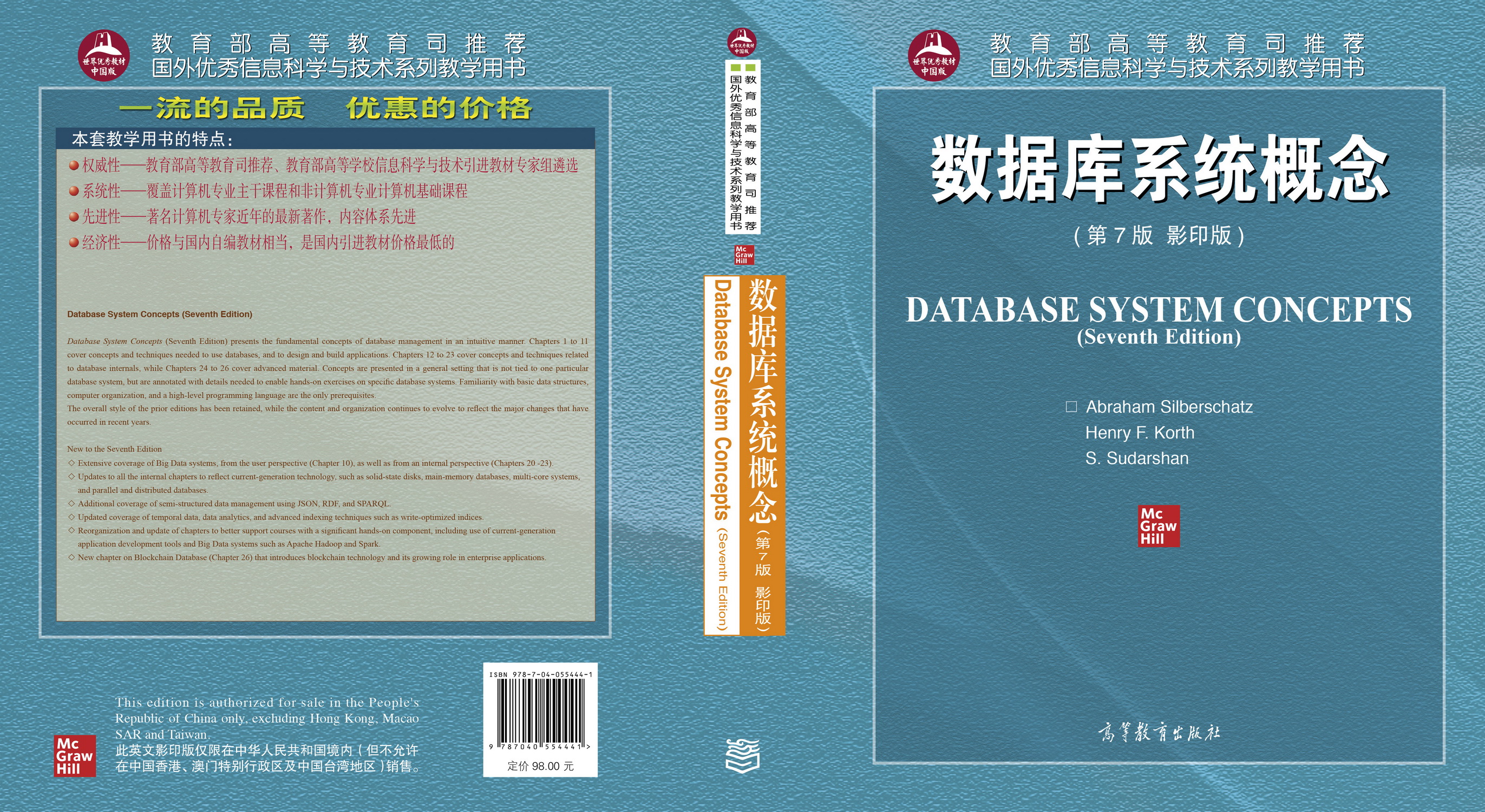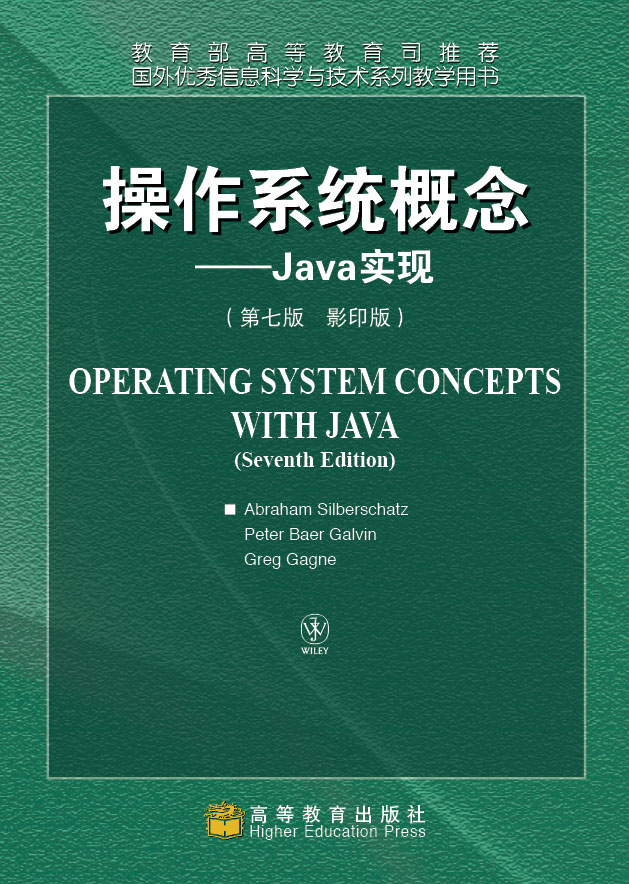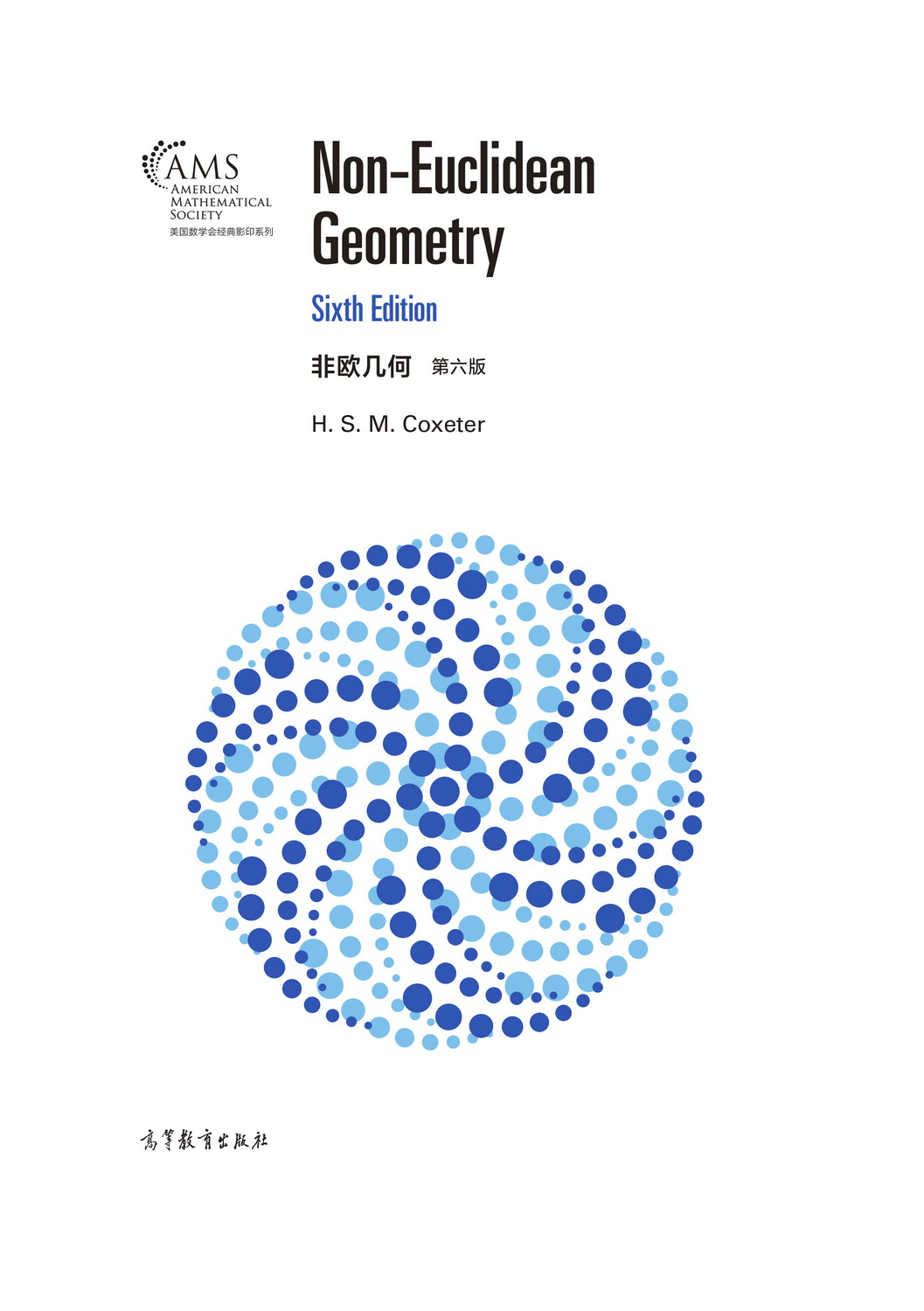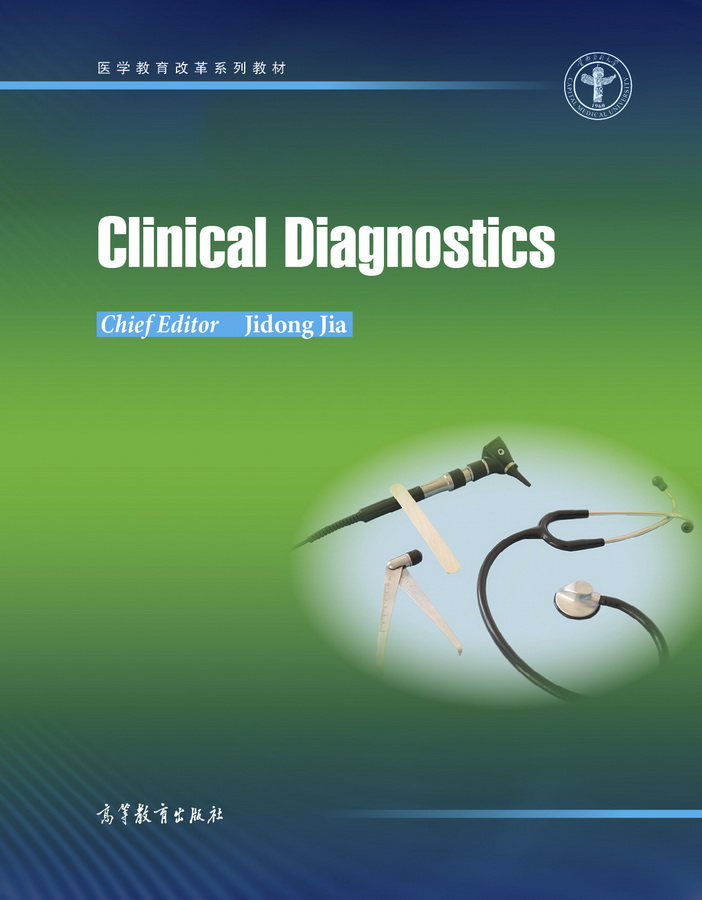数据库系统概念(第7版 影印版) / 教育部推荐引进版教材
作者: [美]Abraham Silberschatz等
出版时间:2021-05
出版社:高等教育出版社
- 高等教育出版社
- 9787040554441
- 1版
- 369794
- 48260971-6
- 平装
- 异16开
- 2021-05
- 1200
- 1376
- 工学
- 计算机类
- 计算机科学与技术
- 本科 研究生及以上
前辅文
Chapter 1 Introduction
1.1 Database-System Applications
1.2 Purpose of Database Systems
1.3 View of Data
1.4 Database Languages
1.5 Database Design
1.6 Database Engine
1.7 Database and Application Architecture
1.8 Database Users and Administrators
1.9 History of Database Systems
1.10 Summary
Exercises
Further Reading
PART ONE RELATIONAL LANGUAGES
Chapter 2 Introduction to the Relational Model
2.1 Structure of Relational Databases
2.2 Database Schema
2.3 Keys
2.4 Schema Diagrams
2.5 Relational Query Languages
2.6 The Relational Algebra
2.7 Summary
Exercises
Further Reading
Chapter 3 Introduction to SQL
3.1 Overview of the SQL Query Language
3.2 SQL Data Definition
3.3 Basic Structure of SQL Queries
3.4 Additional Basic Operations
3.5 Set Operations
3.6 Null Values
3.7 Aggregate Functions
3.8 Nested Subqueries
3.9 Modification of the Database
3.10 Summary
Exercises
Further Reading
Chapter 4 Intermediate SQL
4.1 Join Expressions
4.2 Views
4.3 Transactions
4.4 Integrity Constraints
4.5 SQL Data Types and Schemas
4.6 Index Definition in SQL
4.7 Authorization
4.8 Summary
Exercises
Further Reading
Chapter 5 Advanced SQL
5.1 Accessing SQL from a Programming Language
5.2 Functions and Procedures
5.3 Triggers
5.4 Recursive Queries
5.5 Advanced Aggregation Features
5.6 Summary
Exercises
Further Reading
PART TWO DATABASE DESIGN
Chapter 6 Database Design Using the E-R Model
6.1 Overview of the Design Process
6.2 The Entity-Relationship Model
6.3 Complex Attributes
6.4 Mapping Cardinalities
6.5 Primary Key
6.6 Removing Redundant Attributesin Entity Sets
6.7 Reducing E-R Diagrams to Relational Schemas
6.8 Extended E-R Features
6.9 Entity-Relationship Design Issues
6.10 Alternative Notations for Modeling Data
6.11 Other Aspects of Database Design
6.12 Summary
Exercises
Further Reading
Chapter 7 Relational Database Design
7.1 Features of Good Relational Designs
7.2 Decomposition Using Functional Dependencies
7.3 Normal Forms
7.4 Functional-Dependency Theory
7.5 Algorithms for Decomposition Using Functional Dependencies
7.6 Decomposition Using Multivalued Dependencies
7.7 More Normal Forms
7.8 Atomic Domains and First Normal Form
7.9 Database-Design Process
7.10 Modeling Temporal Data
7.11 Summary
Exercises
Further Reading
PART THREE APPLICATION DESIGN AND DEVELOPMENT
Chapter 8 Complex Data Types
8.1 Semi-structured Data
8.2 Object Orientation
8.3 Textual Data
8.4 Spatial Data
8.5 Summary
Exercises
Further Reading
Chapter 9 Application Development
9.1 Application Programs and User Interfaces
9.2 Web Fundamentals
9.3 Servlets
9.4 Alternative Server-Side Frameworks
9.5 Client-Side Code and Web Services
9.6 Application Architectures
9.7 Application Performance
9.8 Application Security
9.9 Encryption and Its Applications
9.10 Summary
Exercises
Further Reading
PART FOUR BIG DATA ANALYTICS
Chapter 10 Big Data
10.1 Motivation
10.2 Big Data Storage Systems
10.3 The MapReduce Paradigm
10.4 Beyond MapReduce: Algebraic Operations
10.5 Streaming Data
10.6 Graph Databases
10.7 Summary
Exercises
Further Reading
Chapter 11 Data Analytics
11.1 Overview of Analytics
11.2 Data Warehousing
11.3 Online Analytical Processing
11.4 Data Mining
11.5 Summary
Exercises
Further Reading
PART FIVE STORAGE MANAGEMENT AND INDEXING
Chapter 12 Physical Storage Systems
12.1 Overview of Physical Storage Media
12.2 Storage Interfaces
12.3 Magnetic Disks
12.4 Flash Memory
12.5 RAD
12.6 Disk-Block Access
12.7 Summary
Exercises
Further Reading
Chapter 13 Data Storage Structures
13.1 Database Storage Architecture
13.2 File Organization
13.3 Organization of Records in Files
13.4 Data-Dictionary Storage
13.5 Database Buffer
13.6 Column-Oriented Storage
13.7 Storage Organization in Main-Memory Databases
13.8 Summary
Exercises
Further Reading
Chapter 14 Indexing
14.1 Basic Concepts
14.2 Ordered Indices
14.3 B+-Tree Index Files
14.4 B+-Tree Extensions
14.5 Hash Indices
14.6 Multiple-Key Access
14.7 Creation of Indices
14.8 Write-Optimized Index Structures
14.9 Bitmap Indices
14.10 Indexing of Spatial and Temporal Data
14.11 Summary
Exercises
Further Reading
PART SIX QUERY PROCESSING AND OPTIMIZATION
Chapter 15 Query Processing
15.1 Overview
15.2 Measures of Query Cost
15.3 Selection Operation
15.4 Sorting
15.5 Join Operation
15.6 Other Operations
15.7 Evaluation of Expressions
15.8 Query Processing in Memory
15.9 Summary
Exercises
Further Reading
Chapter 16 Query Optimization
16.1 Overview
16.2 Transformation of Relational Expressions
16.3 Estimating Statistics of Expression Results
16.4 Choice of Evaluation Plans
16.5 Materialized Views
16.6 Advanced Topics in Query Optimization
16.7 Summary
Exercises
Further Reading
PART SEVEN TRANSACTION MANAGEMENT
Chapter 17 Transactions
17.1 Transaction Concept
17.2 A Simple Transaction Model
17.3 Storage Structure
17.4 Transaction Atomicity and Durability
17.5 Transaction Isolation
17.6 Serializability
17.7 Transaction Isolation and Atomicity
17.8 Transaction Isolation Levels
17.9 Implementation of Isolation Levels
17.10 Transactions as SQL Statements
17.11 Summary
Exercises
Further Reading
Chapter 18 Concurrency Control
18.1 Lock-Based Protocols
18.2 Deadlock Handling
18.3 Multiple Granularity
18.4 Insert Operations, Delete Operations, and Predicate Reads
18.5 Timestamp-Based Protocols
18.6 Validation-Based Protocols
18.7 Multiversion Schemes
18.8 SnapshotIsolation
18.9 Weak Levels of Consistency in Practice
18.10 Advanced Topics in Concurrency Control
18.11 Summary
Exercises
Further Reading
Chapter 19 Recovery System
19.1 Failure Classification
19.2 Storage
19.3 Recovery and Atomicity
19.4 Recovery Algorithm
19.5 Buffer Management
19.6 Failure with Loss of Non-Volatile Storage
19.7 High Availability Using Remote Backup Systems
19.8 Early Lock Release and Logical Undo Operations
19.9 ARIES
19.10 Recovery in Main-Memory Databases
19.11 Summary
Exercises
Further Reading
PART EIGHT PARALLEL AND DISTRIBUTED DATABASES
Chapter 20 Database-System Architectures
20.1 Overview
20.2 Centralized Database Systems
20.3 Server System Architectures
20.4 Parallel Systems
20.5 Distributed Systems
20.6 Transaction Processing in Paralleland Distributed Systems
20.7 Cloud-Based Services
20.8 Summary
Exercises
Further Reading
Chapter 21 Parallel and Distributed Storage
21.1 Overview
21.2 Data Partitioning
21.3 Dealing with Skew in Partitioning
21.4 Replication
21.5 Parallel Indexing
21.6 Distributed File Systems
21.7 Parallel Key-Value Stores
21.8 Summary
Exercises
Further Reading
Chapter 22 Parallel and Distributed Query Processing
22.1 Overview
22.2 Parallel Sort
22.3 Parallel Join
22.4 Other Operations
22.5 Parallel Evaluation of Query Plans
22.6 Query Processing on Shared-Memory Architectures
22.7 Query Optimization for Parallel Execution
22.8 Parallel Processing of Streaming Data
22.9 Distributed Query Processing
22.10 Summary
Exercises
Further Reading
Chapter 23 Paralleland Distributed Transaction Processing
23.1 Distributed Transactions
23.2 Commit Protocols
23.3 Concurrency Controlin Distributed Databases
23.4 Replication
23.5 Extended Concurrency Control Protocols
23.6 Replication with Weak Degrees of Consistency
23.7 Coordinator Selection
23.8 Consensus in Distributed Systems
23.9 Summary
Exercises
Further Reading
PART NINE ADVANCED TOPICS
Chapter 24 Advanced Indexing Techniques
24.1 Bloom Filter
24.2 Log-Structured Merge Tree and Variants
24.3 Bitmap Indices
24.4 Indexing of Spatial Data
24.5 Hash Indices
24.6 Summary
Exercises
Further Reading
Chapter 25 Advanced Application Development
25.1 Performance Tuning
25.2 Performance Benchmarks
25.3 Other Issuesin Application Development
25.4 Standardization
25.5 Distributed Directory Systems
25.6 Summary
Exercises
Further Reading
Chapter 26 Blockchain Databases
26.1 Overview
26.2 Blockchain Properties
26.3 Achieving Blockchain Properties via Cryptographic Hash Functions
26.4 Consensus
26.5 Data Managementin a Blockchain
26.6 Smart Contracts
26.7 Performance Enhancement
26.8 Emerging Applications
26.9 Summary
Exercises
Further Reading
PART TEN APPENDIX A
Appendix A Detailed University Schema
Index
PART ELEVEN ONLINE CHAPTERS
Chapter 27 Formal Relational Query Languages
Chapter 28 Advanced Relational Database Design
Chapter 29 Object-Based Databases
Chapter 30 XML
Chapter 31 Information Retrieval
Chapter 32 PostgreSQL










